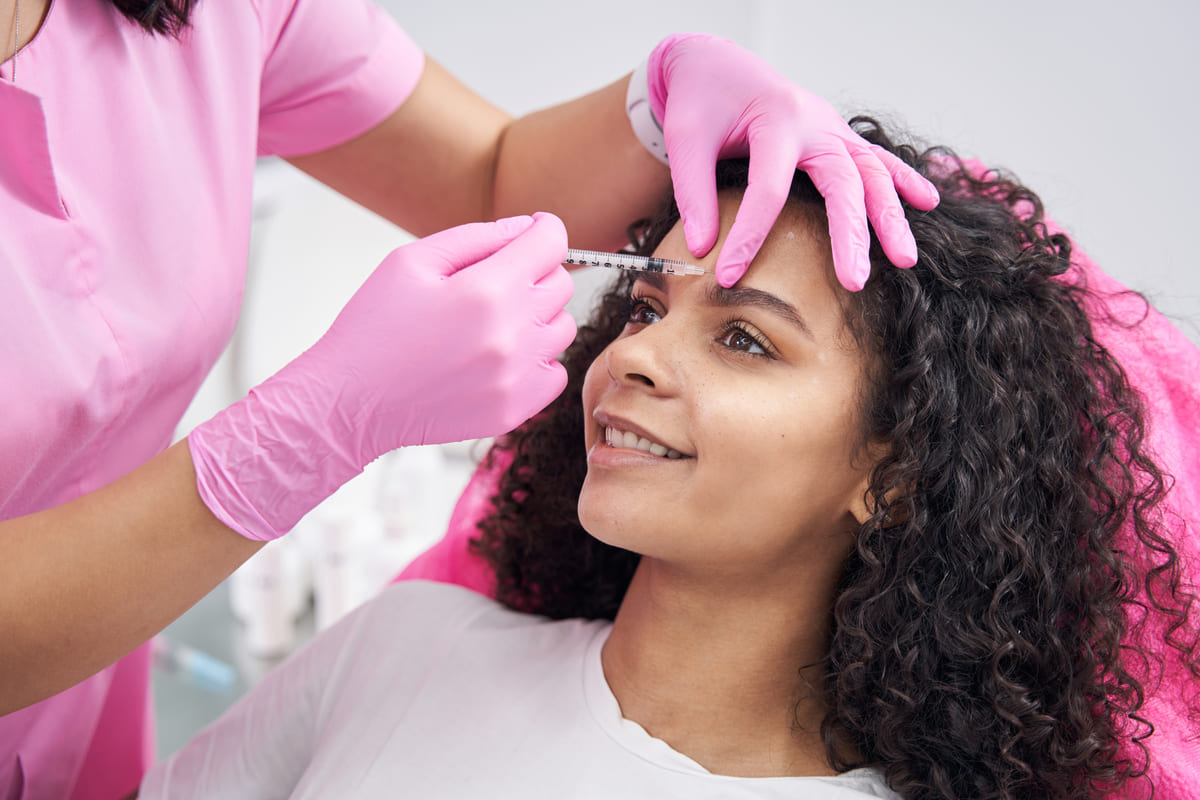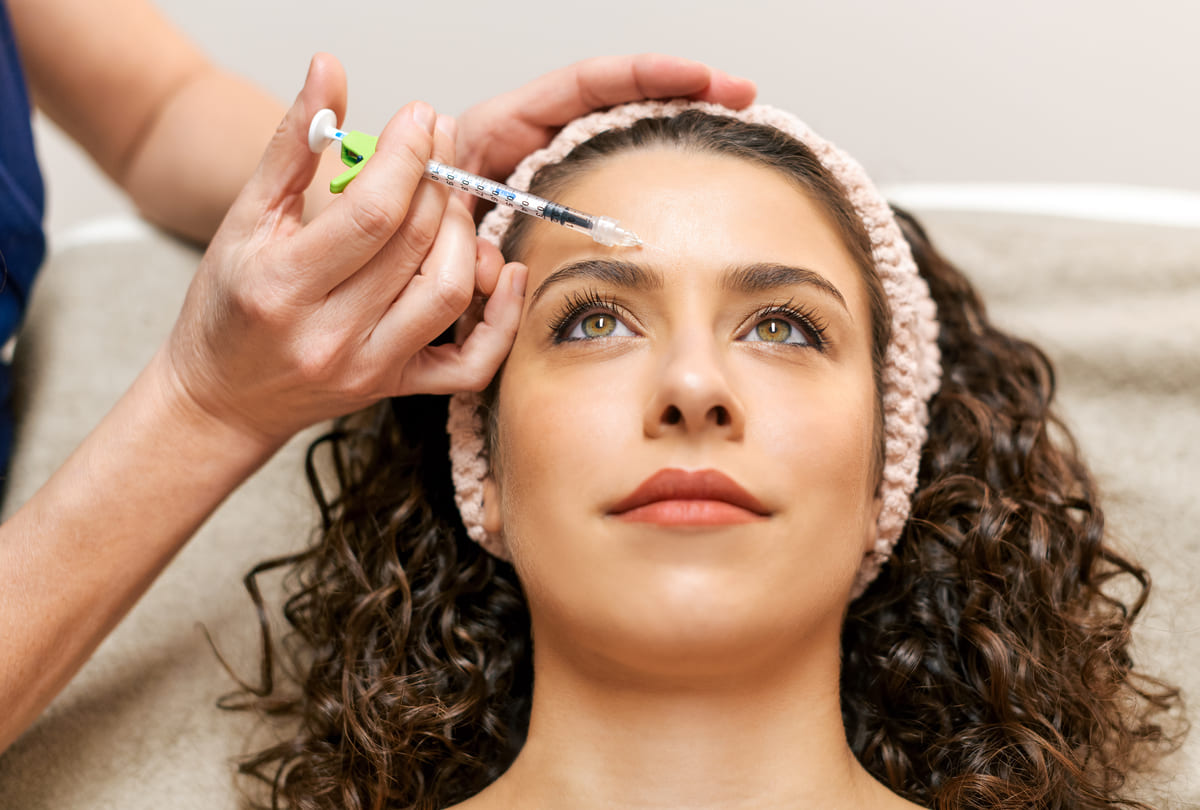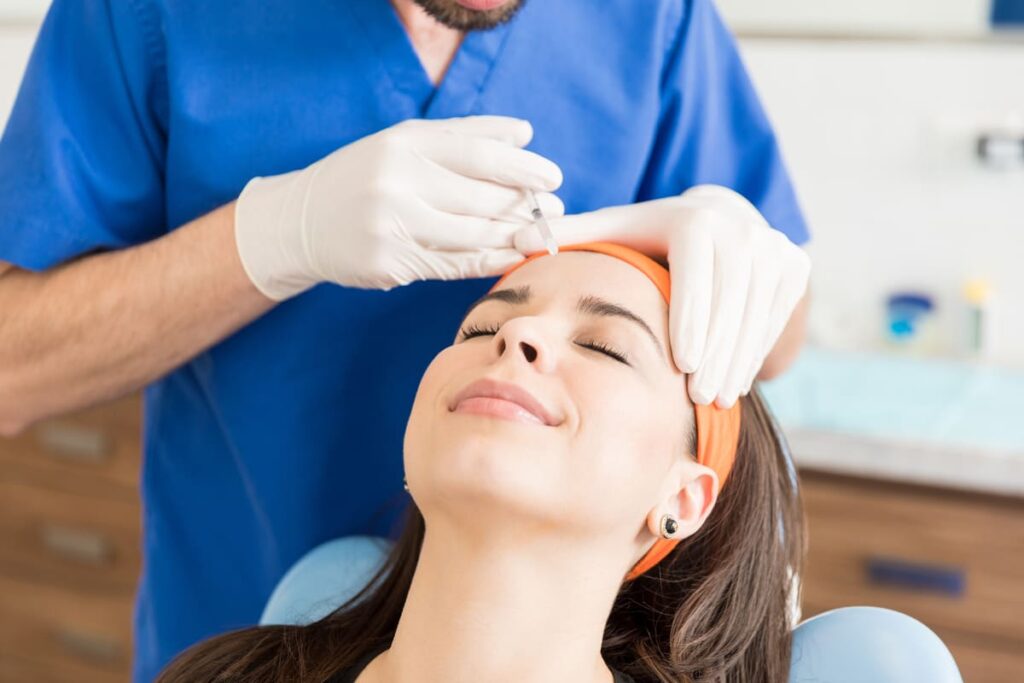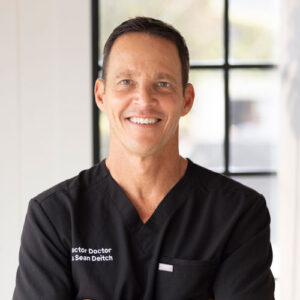Botox and Dysport are both FDA approved wrinkle relaxers used in non surgical facial injections. They temporarily relax the muscles that create expression lines, such as frown lines, forehead creases, and crow’s feet, by blocking nerve signals that cause muscle contraction. Dysport tends to diffuse slightly more broadly in tissue and has a faster onset while Botox tends to stay more localized and takes effect a little slower.
These are not fillers or creams. Instead, they work beneath the skin to soften dynamic wrinkles – lines caused by facial movements like squinting, frowning, or raising the eyebrows. Both are botulinum toxin type A neuromodulators, produced under strict medical manufacturing controls.
In 2023, more than 4.7 million people in the United States chose Botox or Dysport at cosmetic clinics.
In this article, we’ll break down the key differences between Dysport and Botox, explain how each works, and help you determine which option best fits your wrinkle type and aesthetic goals.
What is Dysport and how does it work?
Dysport is a muscle relaxer used to soften lines caused by facial movement. It is made from abobotulinumtoxinA, a type of botulinum toxin created under medical lab controls. This injection is placed into muscles that shape frown lines, forehead wrinkles, and crow feet.
It blocks the nerve signals that make those muscles pull. Once the pull stops, the skin smooths. The full session takes less than twenty minutes and does not need recovery. Dysport treats dynamic wrinkles, which appear from habits like squinting or raising the brows.
It was approved in the United States in 2009 and is now used widely in non surgical wrinkle care. Results can start in two to three days and may spread over larger areas of the face. The effect builds inside the muscle, not on the surface. Most patients return every few months to keep the look they want.

What is Botox and how does it work?
Botox is a muscle relaxer used to reduce facial lines caused by movement. It is made from onabotulinumtoxinA, a type A neurotoxin produced from Clostridium botulinum. The injection targets muscles that create wrinkles during facial expression. Once injected, it blocks nerve signals inside the muscle and stops contractions that pull the skin into folds.
Common treatment areas include frown lines between the eyebrows, horizontal lines across the forehead, and crow feet near the outer eyes. These wrinkles come from repeated habits like squinting or raising the brows. When the muscle activity stops, the skin above starts to look smoother and more even.
Each session takes around 15 to 20 minutes. No numbing is required. Most people return to their routine right away without needing any rest or recovery. It is a fast treatment used widely in cosmetic care.
Botox was first approved in the United States in 2002 for cosmetic use. Since then, it has become one of the most common non surgical face injections offered in clinics. It is used to manage movement-based wrinkles with a short visit and a long track record of safe results.
What is the difference between Dysport and Botox
Botox and Dysport are both used in wrinkle care to treat lines caused by muscle movement. They work through the same type of toxin but act a bit differently once injected. These small changes matter. The next few sections explain what sets them apart.
| Feature | Botox | Dysport |
| Main Ingredient | onabotulinumtoxinA | abobotulinumtoxinA |
| Wrinkle Type Treated | dynamic lines from expression | dynamic lines from expression |
| Time to Start Working | around 3 to 7 days | around 1 to 3 days |
| Peak Results | up to 14 days | up to 14 days |
| Duration of Results | about 3 to 4 months | about 3 to 4 months (some see up to 5) |
| Spread in Muscle | stays close to injection site | spreads wider inside tissue |
| Best Use Areas | Smaller Precise Areas | Broader zones needing wider coverage |
| Typical Dose Ratio | fewer units needed | needs more units for same result |
| Unit Conversion | 1 Botox unit ≈ 2.5 to 3 Dysport units | 2.5 to 3 Dysport units ≈ 1 Botox unit |
| Session Time | 10 to 20 minutes | 10 to 20 minutes |
How Fast Dysport and Botox Start Working
Dysport acts faster than Botox. Many people start seeing smoother areas within 2 or 3 days. The treated muscles respond early, helping relax visible lines on the forehead, between the brows, or near the eyes. This fast start can feel noticeable in the first few days after the visit.
Botox works at a slower pace. Most results start to show between day 3 and day 7. The full effect builds in the muscle over 10 to 14 days. For those who prefer a softer change, this gradual timing may feel more balanced across the face.
Both products affect how the muscles move under the skin. As the nerve signals stop reaching the target area, wrinkle motion fades. The skin smooths in steps as the muscle stays relaxed longer.
If you have a special event coming soon, Dysport may suit your timeline. If you want slower progress without fast facial change, Botox can match that pace. Both lead to muscle relaxation, but the timing feels different person to person.
How Long Results Last for Dysport and Botox
Both Dysport and Botox results last 3 to 4 months for most people. After that, movement in the treated muscles slowly returns, and wrinkles begin to show again. To keep the skin looking smooth, many patients schedule another session around month 3 to maintain results before lines fully come back.
In some cases, Dysport may hold slightly longer. A few people see results stay up to 5 months. This does not happen for everyone. Longevity depends on factors like muscle strength, how the body responds, and the area treated during the session.
How long the effect lasts also depends on the dose, where the injection was placed, and how quickly the body breaks it down. Some areas lose effect faster than others based on facial movement. This is why follow-up visits help keep wrinkle control consistent.
Most people return for Botox or Dysport 3 to 4 times a year. This pattern keeps the muscles relaxed and helps avoid deep lines from returning between treatments. Wrinkle relaxers work best when used before the full movement comes back.
How Botox and Dysport Spreads in the Face After Injection
Dysport spreads across a wider area after injection. Botox stays closer to the target point and holds in a tight space. This difference helps your provider decide how to cover muscle zones with fewer units or more precise control. Dysport works across the surface faster. Botox stays focused and exact.
Most providers match the product to the treatment zone. Wide areas need fewer injection points with a spreading product. Small muscles near sensitive spots need tighter control. Based on this, they choose what fits each location.
Dysport is work best for:
- Forehead lines that stretch across the upper face
- Broad zones needing fewer injections
- Fast treatment across moving muscle areas
Botox is often used for:
- Crow feet near the corners of the eyes
- Frown lines between the brows
- Small muscle areas where spread must stay controlled
This difference is due to formulation and reconstitution, not because one has “smaller” or “larger” core toxin molecules—the active neurotoxin is the same 150 kDa protein in both.
A skilled injector studies your muscle movement and selects the right product for each part of your face.
What Are the Unit Differences in Botox and Dysport
Botox and Dysport use different unit systems. Botox is more concentrated, so it takes fewer units to relax a muscle. Dysport uses smaller units, so the number looks higher even when the effect is the same. The unit count may be different, but the outcome is matched.
Most providers follow a 3 to 1 ratio. This means 1 unit of Botox is often balanced with 3 units of Dysport. If a treatment calls for 20 units of Botox, it may take 60 units of Dysport to get the same result. The dose changes, but the muscle control stays equal.
| Treatment Zone | Botox Units | Dysport Units |
| Frown lines | 20 | 60 |
| Forehead | 10 to 20 | 30 to 60 |
| Crow feet (both sides) | 24 | 72 |
| Average ratio | 1 | 2.5 to 3 |
Unit pricing can be confusing. Botox costs more per unit, but fewer are needed. Dysport costs less per unit, but the total number is higher. In most cases, the full session price is about the same. Skilled injectors adjust the dose based on facial muscle size and the treatment zone.
Safety and Side Effects of Botox and Dysport
Both Botox and Dysport are made from botulinum toxin type A and work the same way. Most side effects are mild and short-term. Redness, swelling, soreness, or a headache may occur after the injection and fade within a few hours.
In rare cases, the toxin may spread beyond the target area. This can lead to a droopy eyelid, slight muscle weakness, or, if placed too close to the neck, trouble swallowing.
These effects are uncommon and linked to incorrect placement.
Botox Side Effects
- Redness or mild swelling
- Bruising or muscle soreness
- Short-term headache
- Eyelid droop if injected near eye muscles
- Weakness in nearby muscles if spread
- Rare swallowing issue with neck-area injection
Dysport Side Effects
- Swelling or tenderness near the injection site
- Light bruising
- Headache or pressure feeling
- Higher risk of spread near eyelids
- Unwanted movement in sensitive areas
- Swallowing trouble if injected too low
A skilled provider adjusts the dose and placement to avoid these issues. Both products spread differently, so the choice depends on muscle location and depth.
People with nerve problems, pregnant or breastfeeding women, or anyone allergic to ingredients in the formula should avoid these treatments. Medical history must always be reviewed first.

Benefits of Botox and Dysport Injections
Both Botox and Dysport are non surgical injections that reduce expression lines. Each one targets facial muscles to smooth movement patterns linked to forehead folds, brow creases, or eye lines.
Treatments are short, with no recovery time. People return for repeat visits as needed. Results build in layers across small or broad zones depending on the muscle area treated.
Advantages of Botox Injections
Botox is used when wrinkle control needs high accuracy. It stays close to the injection point, making it useful for zones that demand sharp control.
- Targets crow feet and brow folds directly
- Delivers results in tight muscle clusters
- Holds effect in a fixed location
- Reduces lines without spreading to nearby areas
- Commonly used around the eyes
- Ideal for patients with subtle movement in small zones
Dysport Treatment Benefits
Dysport spreads wider after injection, which helps in zones where coverage matters more than precision.
It reaches more muscle surface and starts showing results within 1 to 3 days.
- Covers broad areas like the forehead with fewer injections
- Matches surface patterns across larger zones
- Starts acting faster than Botox
- Useful for people with strong facial movement
- Short sessions for full-face coverage
Who Should Avoid Botox or Dysport
People with certain health risks should not receive wrinkle relaxer injections. These include those with nerve disorders, active skin infections, or a past reaction to any botulinum toxin. These injections affect how facial muscles respond, so any risk must be removed upfront.
Wrinkle relaxers should also be avoided during pregnancy or while breastfeeding. Anyone with an allergy to product ingredients must not proceed with treatment.
These safety filters protect muscle zones and prevent the toxin from spreading outside its target area. Before any injection, your medical background must be reviewed. This includes breathing conditions, muscle disorders, and any medication that affects how the body handles toxin-based treatments.
These checks support safe results and help prevent unwanted effects during and after the session.
How to Choose Between Botox and Dysport
Choosing between Botox and Dysport depends on what you want to treat, how fast you need results, and how your face moves. Both smooth lines, but each works a bit differently under the skin. Small details like zone size and wrinkle depth can guide your choice.
| Your Goal or Concern | Better Option to Consider |
| I want results in a few days | Dysport (starts working in 1–3 days) |
| I need to treat a wide area like the forehead | Dysport (spreads further with fewer injections) |
| I want tight control in small muscle zones | Botox (holds near the injection site) |
| I am new to wrinkle treatments | Botox (gradual change feels more subtle) |
| I want a soft look, not too frozen | Dysport (may look more relaxed in large zones) |
| I need a crisp result in a focused area | Botox (often used for brow and eye corners) |
If it’s your first wrinkle injection, how fast results appear can make a difference. Botox builds gradually, which feels softer over a few days. Dysport acts faster, often helpful when time is tight.
- Decide how quickly you want to see the change
- Pick based on the size of the area being treated
- Ask if you prefer a gradual effect or faster results
- Find out which one fits your wrinkle zones best
- Both are trusted options used in repeat care
Not sure where to begin? At Doctor Doctor in Solana Beach, many patients try one first and switch later based on how their face responds or how long results hold.
Final Thoughts
Botox and Dysport are both used to reduce wrinkles without surgery. They target facial muscles to soften lines on the forehead, between the brows, and around the eyes. Each option supports safe, lasting improvement with minimal time away from your day.
Doctor Doctor in Solana Beach provides both treatments for patients across North County San Diego. Whether it is your first session or part of a routine plan, we match the right product to your face, goals, and treatment area using expert injection technique.
Sources
- https://www.mayoclinic.org/tests-procedures/botox/about/pac-20384658
- https://pubmed.ncbi.nlm.nih.gov/22052270/
- https://www.healthline.com/health/dysport-botox
- https://www.webmd.com/drugs/2/drug-153182/dysport-intramuscular/details
- https://www.medsafe.govt.nz/consumers/cmi/d/dysport.pdf
- https://health.clevelandclinic.org/dysport-vs-botox
- https://www.drugs.com/medical-answers/dysport-botox-difference-3124590/




